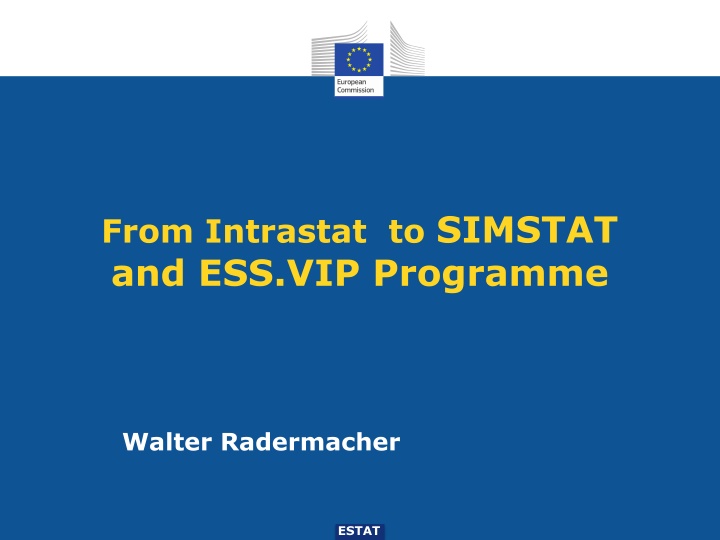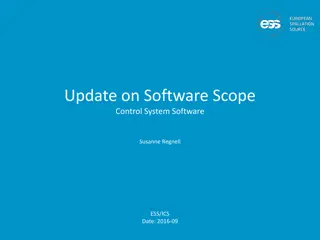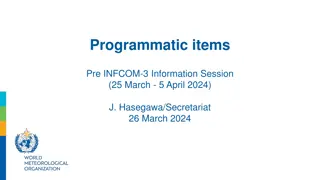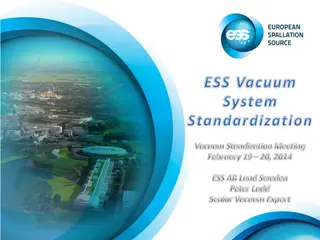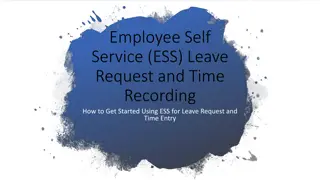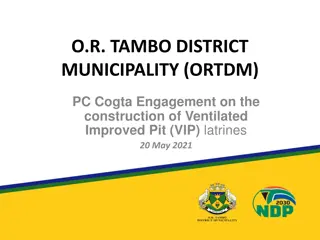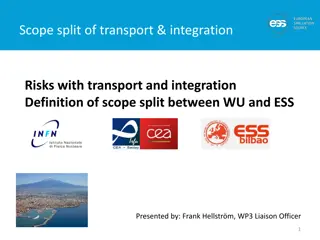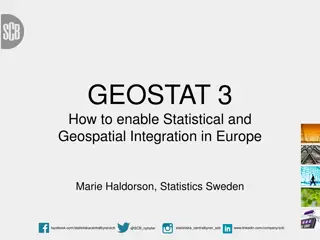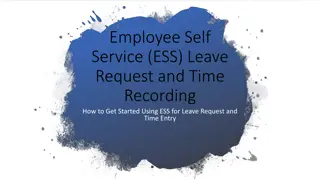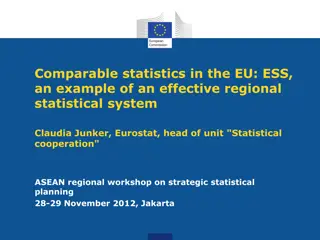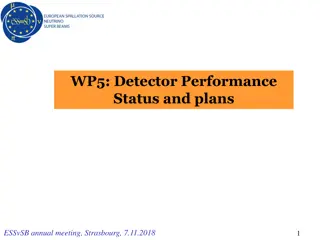SIMSTAT and ESS.VIP Programme
Explore the transition from Intrastat to SIMSTAT and the ESS VIP Programme led by Walter Radermacher, showcasing the evolution of ESTAT data management practices in a modern context.
Download Presentation

Please find below an Image/Link to download the presentation.
The content on the website is provided AS IS for your information and personal use only. It may not be sold, licensed, or shared on other websites without obtaining consent from the author.If you encounter any issues during the download, it is possible that the publisher has removed the file from their server.
You are allowed to download the files provided on this website for personal or commercial use, subject to the condition that they are used lawfully. All files are the property of their respective owners.
The content on the website is provided AS IS for your information and personal use only. It may not be sold, licensed, or shared on other websites without obtaining consent from the author.
E N D
Presentation Transcript
From Intrastat to SIMSTAT and ESS.VIP Programme Walter Radermacher ESTAT
Modern design of Statistics = multiple sources, multimode data collection, enhanced quality Principles: re-using existing data and compiling different data sources before going for surveys if the survey is run, the most modern technologies should be used statistical quality should be ensured with moving validation as early as possible into the production chain 2 Walter Radermacher ESTAT
Modern design of statistics example Census Combines different sources: administrative registers, geographical data, sample survey data Employs mixed mode data collection (CAWI, CATI) Uses output quality orientation with emphasis on the validation at the beginning of the production chain 3 Walter Radermacher ESTAT
Transition problems: Census Risks of the new model: Complexity Acceptability Lack of control Degree of abstraction Uncertainty (if sampling used) Dependency from administrative sources 4
Why analogy with Census 2011? Intrastat is a census-type statistical survey, carried out monthly and covering both import and export Intrastat is an expensive survey generating around 50% of the administrative burden from official statistics Similar risks plus cross-border risk components 5 Walter Radermacher ESTAT
SIMSTAT project A modern multiple source / mixed mode design of trade statistics The first domain for implementing exchange micro data for statistical purposes; 6 Walter Radermacher ESTAT
SIMSTAT = principles of modern design of trade statistics Re-uses available information (by making micro-data on export of other MS available) Thus: opening up the possibility of gradually replacing the import survey by other sources providing opportunities for improving quality of import flow, i.e. through using as far as possible sampling surveys for quality assurance 7 Walter Radermacher ESTAT
SIMSTAT: first application of the ESS.VIP Programme principles Exchange of micro-data requires: 8 Walter Radermacher ESTAT
Physical Networks such as EDAMIS, CCN-CCI; Shared services accompanying data exchange; Application software and hardware at both national and European level; Standards for data exchange (SDMX and DDI) and appropriate legal frameworks. 9 Walter Radermacher ESTAT
Where are we one year later? Results from Phase 1 of the project: feasibility study: Consensus on the centralised hub based system for micro-data exchange; Identified options for infrastructure (EDAMIS, CCN/CCI). Lessons learned and difficulties to overcome: Confidentiality issues related to microdata exchange; Mutual trust among ESS partners. 10 Walter Radermacher ESTAT
The main challenge at this stage Ensuring that the solutions chosen for SIMSTAT will be reusable by the other statistical domains, business ESS.VIPs respectively while the roadmap for SIMSTAT is respected; 11 Walter Radermacher ESTAT
What is ESS.VIP and why? Integrated production system ("back office") Exchanging micro data and using them for compiling statistics Reduce redundancies and duplications in data validation procedures Standardised and shared services, supported by common IT tools Elements of the computing resources (e.g. networks, servers, storage, applications and services) be safely shared through cloud computing and thus reduce the investments and maintenance costs Part of the ESS system (i.e. one or a limited number of NSIs) perform a service for the rest acting as a Centre of Competence Conditions in terms of legal and financial frameworks 12 Walter Radermacher ESTAT
Structure of the programme Pillar I: Cross-cutting projects (ESS.VIP.CRC). These projects aim at developing key building blocks of the common infrastructure for a more integrated ESS in the future. The following four projects are components of this pillar (Standards and Information models, European Statistical Data Exchange Network, Shared services, Data Warehouses). Pillar II: Business projects (ESS.VIP.BUS). These projects focus on individual statistical domains. Seven projects are considered to be elements of this pillar of which three were launched in 2012 (SIMSTAT, Common Data Validation Policy, ESBRs). One new project will be proposed for endorsement by the ESSC in May 2013, namely the ICT Statistical production and dissemination based on shared services and four other are still in preparation with active participation of the MS. Pillar III: Administrative projects (ESS.VIP.ADM). These projects aim at defining the governance of the system, the actors, their responsibilities, the resources committed, the administrative mechanisms, the implementation strategy and the associated communication. 13 Walter Radermacher ESTAT
Thank you for your attention! Walter.Radermacher@ec.europa.eu http://ec.europa.eu/eurostat 14 ESTAT
